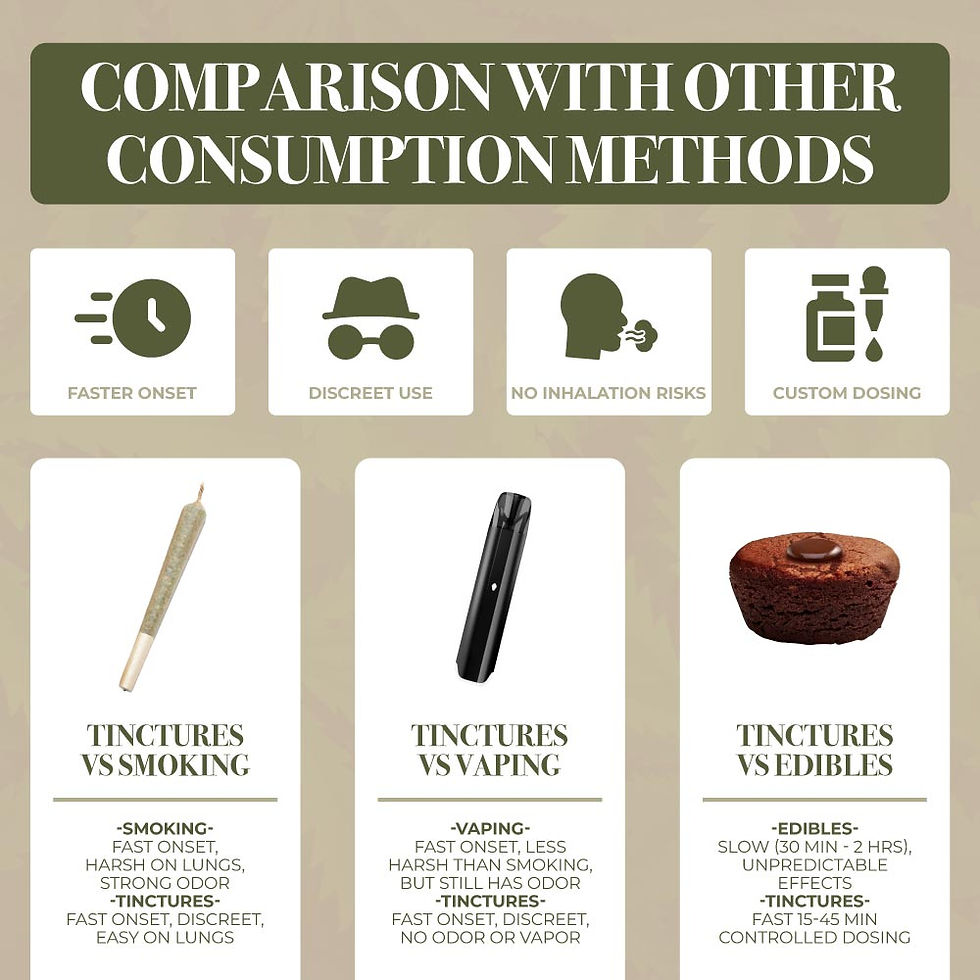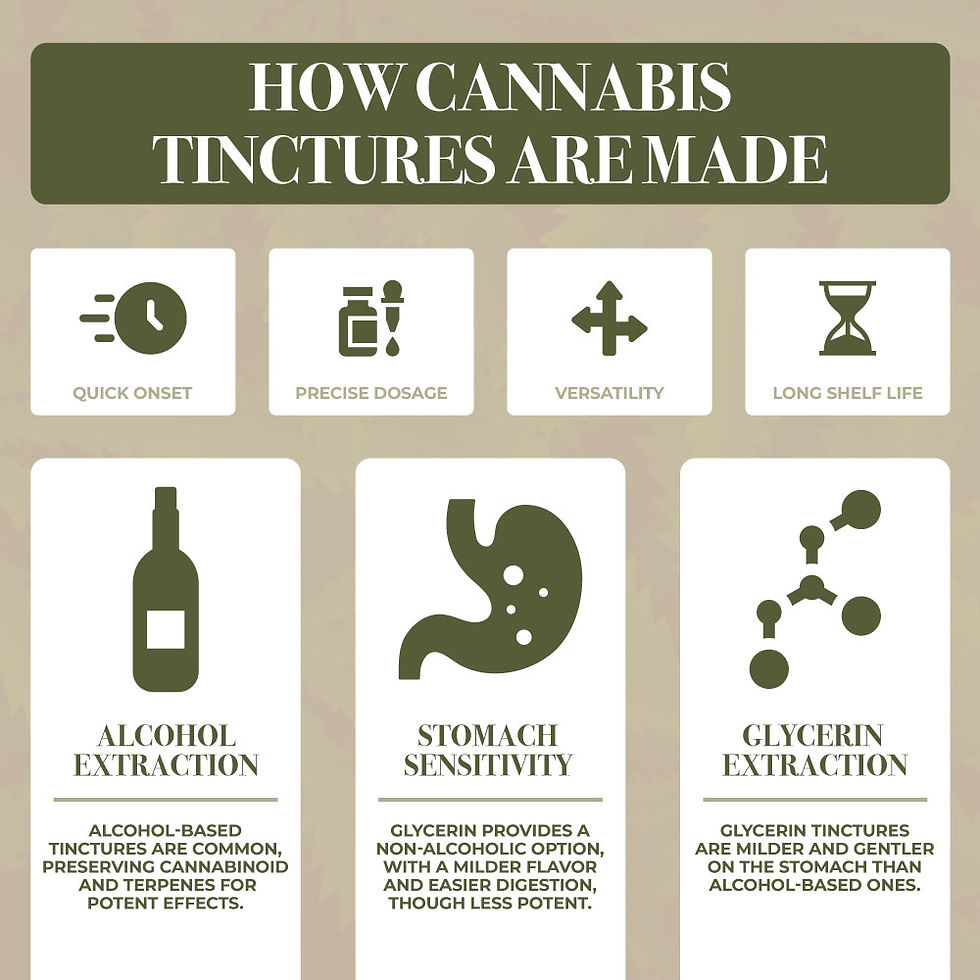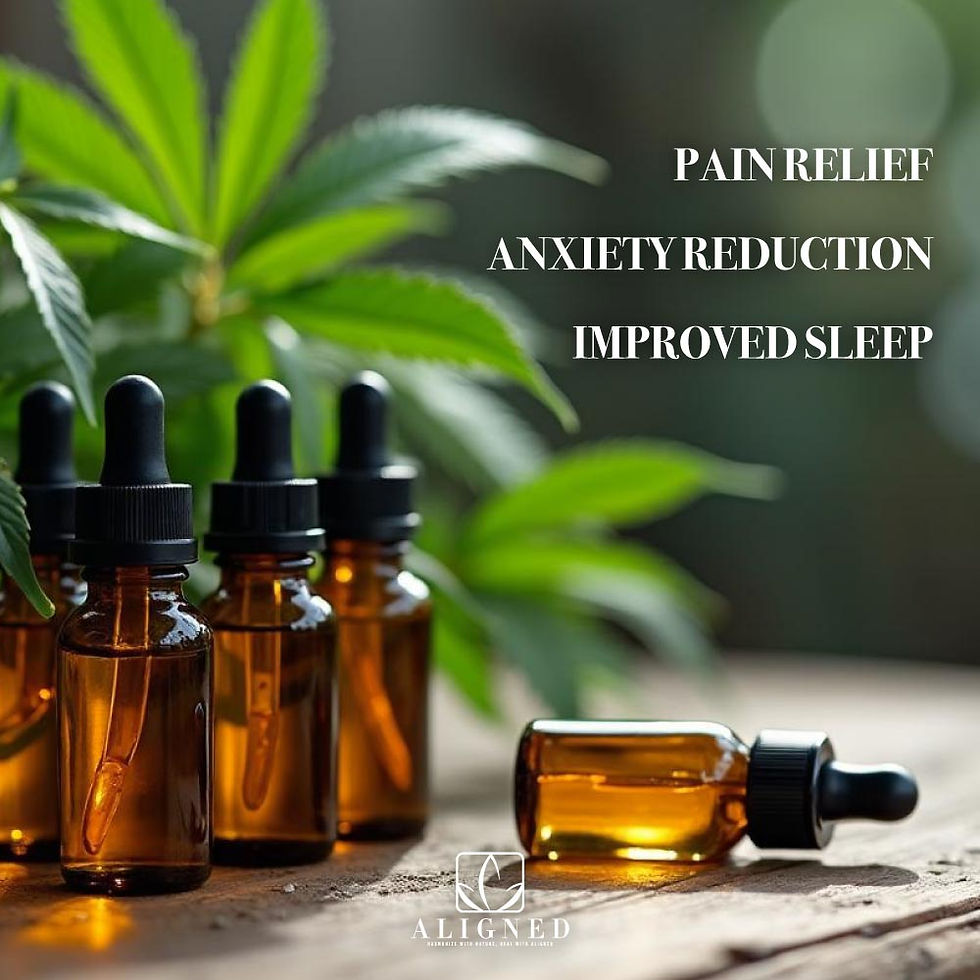What Are Cannabis Tinctures: Everything You Need To Know
- Top Level DC
- Nov 15, 2024
- 11 min read

Cannabis tinctures have made their way from old-school apothecaries to today’s cannabis shops, where they're popping up as a discreet, easy-to-use option for anyone wanting to experience the benefits of cannabis. With a quick dropper full under the tongue or mixed into a smoothie, a cannabis tincture offers an effective, smoke-free way to get all the good stuff without the, well, puff-puff. This guide covers everything from what exactly tinctures are to why they might be the perfect match for your vibe—especially if rolling a joint feels like a whole project.
What Is A Cannabis Tincture?
Definition And Background
So, what is a cannabis tincture? Think of it as the espresso shot of the cannabis world—a small but strong bottle of liquid made by soaking cannabis in alcohol (or other solvents), allowing the cannabinoids, like THC and CBD, to infuse into the liquid. The result is a super-concentrated, highly potent elixir.
Tinctures aren't exactly a new trend. In fact, they were once staples of pharmacies, where herbal extracts like cannabis were used for medicinal purposes long before the pill-popping era. Your great-great-grandparents probably sipped or dropped tinctures of all kinds to manage anything from aches and pains to stress (and given how life was back then, they probably needed it).

Comparison With Other Consumption Methods
Here’s the tea: tinctures can be a real game-changer in the world of cannabis. When we think of ways to consume cannabis, most people imagine the classics: edibles, smoking, and vaping. But tinctures? They’re in a category of their own. Let’s break it down.
Tinctures vs Edibles
With edibles, you’re in for a rollercoaster. They can take anywhere from 30 minutes to 2 hours to kick in, and then suddenly, you’re rethinking every decision you ever made because, whoa, did you really need that whole brownie? If this has ever happened to you, make sure you check out ways to sober up real fast from weed.
A cannabis tincture can start working much faster (especially if you use them sublingually, aka under the tongue). You’ll usually feel them within 15-45 minutes, giving you a little more control. Plus, you get to decide how much of a buzz you’re signing up for with the dropper.
Tinctures vs Smoking
Smoke can be harsh on the lungs, not to mention lingering like a not-so-subtle reminder that you've been "relaxing." Tinctures? No smoke, no smell, no problem. They’re discreet, too—people don’t blink an eye if they see you drop something under your tongue. Little do they know it’s your “happy juice.”
Tinctures vs Vaping
Vaping can be quick and efficient, but it’s still not odor-free and carries some potential health concerns. With tinctures, you get the same speedy onset without any gadgets, charging, or clouds of vapor. It's like cannabis consumption for the minimalist.
In short, tinctures might just be the lazy person’s best friend in the cannabis world. They're versatile, discreet, and easy on the lungs—and with none of the unpredictability of edibles. For those who like to keep their cannabis experience efficient and low-key, tinctures are here, with no drama, ready to drop right into your day (or night).

How Cannabis Tinctures Are Made
So, how do these magical little bottles come to be? The process of making cannabis tinctures isn’t as mystical as it might sound and there is no particular cannabis tincture recipe out there. How you make cannabis tincture products depends on a variety of factors. However, it usually involves a simple extraction process that pulls out the cannabinoids (the compounds responsible for the effects) and other goodies from the plant using either alcohol or glycerin. Let’s dive in.
Extraction Process
The two main solvents used in tincture-making are alcohol and glycerin, each bringing its own vibe to the tincture game.
Alcohol Extraction: Alcohol-based tinctures are the most common and effective because alcohol is fantastic at preserving cannabinoids and terpenes (those compounds that give cannabis its unique effects and flavors). The process generally involves soaking ground cannabis in high-proof alcohol for a while, allowing the active compounds to dissolve. Then, the liquid is strained to remove the plant material, leaving a potent, long-lasting tincture.
Glycerin Extraction: For those who prefer a non-alcoholic option, glycerin can be used as a solvent. Glycerin tinctures are a bit gentler in flavor and can be easier on the stomach. The process is similar, but glycerin doesn’t extract quite as well as alcohol, meaning these tinctures might be a bit less potent.
Types Of Cannabis Tinctures
When it comes to cannabis tinctures, variety is the spice of life. You’ve got options, whether you want a purely relaxing experience, a gentle buzz, or something balanced in between.
CBD-Dominant Tinctures
These tinctures focus on CBD, the non-psychoactive compound known for its calming and therapeutic effects without getting you high. Perfect for those who want to feel chill but still functional.
THC-Dominant Tinctures
Here’s where things get interesting. THC-dominant tinctures provide the psychoactive effects that some people love. These are great if you’re looking for a stronger experience but still want control over the dosage.
Balanced Tinctures (CBD)
For those who want the best of both worlds, balanced tinctures offer a mix of CBD and THC, usually in a 1:1 ratio. This combo tends to create a more relaxed, mildly euphoric effect, balancing calm with a bit of spark.
DIY Tinctures vs. Store-Bought
Feeling crafty? Making your own tincture at home is possible, but it requires patience, precision, and a willingness to embrace a few unknowns. Store-bought tinctures, on the other hand, come with lab-tested potency, clear labeling, and consistency—so you know exactly what you’re getting with every drop.
How To Use Cannabis Tinctures
Alright, now that you’ve got your tincture, how do you actually use it? Below, we share how to use cannabis tincture products properly:
Sublingual Dosing
Sublingual dosing means placing the tincture under your tongue and letting it absorb for a minute or two before swallowing. This method is popular for its quick onset and higher absorption rate. Here’s how to do it:
Measure the Dose: Use the dropper to measure out the amount you want. Start small if you're new to tinctures!
Place Under the Tongue: Squirt the liquid under your tongue.
Hold It There: Hold it for about 60-90 seconds. This might feel a little weird, but trust the process—this helps the cannabinoids absorb directly into your bloodstream through the tissues under your tongue.
Swallow: After holding, go ahead and swallow. You’ll feel the effects faster than if you’d just swallowed it right away.
Why Sublingual Absorption?
Sublingual cannabis tincture dosing lets the product hit you faster and more effectively than if you just swallowed it outright, which has to go through your digestive system. This direct absorption under the tongue bypasses the liver’s “first-pass metabolism,” which is just a fancy way of saying it gets the job done quicker and with less potency lost.
Dosage Guidelines
When it comes to cannabis tincture dosing, there’s no “one-size-fits-all.” Your perfect dose depends on factors like experience, tolerance, body weight, and metabolism. Here’s a rundown to help you find your sweet spot.
Cannabis Tinctures For Beginners:
If you’re new to cannabis or just starting with tinctures, start low and go slow. A typical starting dose might be around 2.5-5 mg of THC or CBD, depending on the type of tincture. Take this amount, wait an hour or two to see how it affects you, and adjust as needed. Remember, tinctures can feel more potent when absorbed sublingually, so ease in!
And here’s a pro tip: don’t hesitate to ask the dispensary staff about the right dosage. They can help you pick a good starting point and explain how to use the dropper for accuracy. Remember, tinctures can feel more potent when taken under the tongue, so take it easy and enjoy the experience!
Cannabis Tinctures For Experienced Users:
If you’ve been around the cannabis block, you probably have a good sense of what your tolerance can handle. Even so, tinctures can sometimes surprise you with their potency, so consider starting with around 10 mg if you’re experienced and adjusting from there.
Factors That Influence Cannabis Tincture Dosage:
Things like body weight, metabolism, and even the time of day can impact how you feel after taking a tincture. If you have a faster metabolism, you might feel the effects more quickly but for a shorter time. Your tolerance also plays a big role—longtime cannabis users might need a bit more to feel the same effects as someone with a lower tolerance.
Mixing With Food And Drinks
Not everyone wants to take their tincture straight, and that’s okay! Tinctures are versatile and easy to integrate into your food or drinks for a subtle cannabis experience.
How to Add Tinctures To Food and Drinks:
Just add a few drops to whatever you’re eating or drinking. Tinctures mix well with most liquids and can be added to your morning coffee, smoothie, or evening tea. If you’re going for a savory dish, drop some into salad dressing or drizzle it over pasta. Just remember, when consumed this way, it may take longer for you to feel the effects since it’ll go through your digestive system.
Popular Ways To Use Tinctures In Food And Drink
Coffee or Tea: Add a few drops to your morning or evening beverage for a chill start or end to the day.
Smoothies: Blend a tincture into your smoothie to make it part of your daily wellness routine.
Salad Dressing: Add it to a vinaigrette or creamy dressing for a little extra zing.
Sweets and Desserts: Drop it into a batch of homemade brownies or cookies if you’re feeling fancy.

Cannabis Tincture Benefits
There are a lot of cannabis tincture benefits you can experience, from therapeutic effects to the ease of discreet consumption.
Therapeutic Benefits
Many people use cannabis tinctures for their therapeutic potential, offering relief from common issues without the need to smoke or vape.
Pain Relief: Tinctures, especially those high in CBD, are popular for managing chronic pain. They offer targeted relief, and the fast-acting nature of sublingual dosing makes them a favorite for people looking for quick comfort.
Anxiety Reduction: CBD-dominant tinctures are widely known to help with anxiety and stress. Unlike THC, CBD doesn’t get you high, so it’s perfect for anyone wanting to manage anxiety or stress without the buzz. The controlled dosage of tinctures allows people to find a calming balance without feeling overwhelmed.
Sleep Improvement: Whether it’s a CBD-dominant tincture or a balanced one, many people find that cannabis tinctures help them relax and improve their sleep quality.
Discreet Consumption
Not everyone wants to broadcast their cannabis use, and that’s where a cannabis tincture really shines.
Convenient and Low-Key: With tinctures, there’s no smoke, no smell, and no big apparatus needed—just a tiny bottle and a dropper.
Controlled Dosing: Since tinctures come with a dropper, it’s easy to measure exactly how much you’re taking. This precision allows for a consistent, tailored experience every time.
For those who want a subtle, controllable, and effective way to use cannabis, tinctures are an ideal option. Just a few drops, and you're good to go—no smoke, no smell, and a whole lot of chill.
Potential Side Effects Of Cannabis Tinctures
Cannabis tinctures are generally well-tolerated, but as with any supplement, they can come with potential side effects. Knowing cannabis tincture side effects and how to manage these effects can help make your experience smoother.
Common Side Effects
Some common side effects of cannabis tinctures include:
Dry Mouth: Also known as "cottonmouth," dry mouth is a typical side effect of cannabis products.
Dizziness: Some individuals, especially those new to cannabis, may experience lightheadedness.
Nausea: Though less common, nausea can occur, particularly with higher doses or for those sensitive to THC.
Mitigating Side Effects
There are effective ways to reduce or prevent potential side effects:
Start with a Low Dose: Starting with a small amount allows your body to adjust gradually, minimizing the chance of experiencing unwanted effects.
Stay Hydrated: Drinking water can help manage dry mouth and reduce dizziness.
Consider Eating First: Consuming a small meal before taking your tincture may help prevent nausea.
Legal Considerations And Responsible Usage
Let’s talk about legality and keeping things chill with cannabis tinctures—because, yeah, it’s crucial for a safe, smooth experience.
Legal Status
The legality of cannabis tinctures is one of those “depends where you are” deals. Here’s the lowdown:
In the Clear Zones: If you’re in a place where cannabis is fully legal, you’re good to go. Tinctures are usually available at licensed dispensaries, so just head on over.
Medical-Only Zones: Some regions play it stricter, allowing cannabis only for medical use. In these areas, you’ll need a doctor’s note or a medical card to pick up a tincture.
No-Go Zones: There are still places where cannabis is a no-go, meaning tinctures are off-limits too. So, before you buy or carry one around, check the local rules—no one needs a legal hassle over a little bottle of concentrate.
Responsible Use
Being smart with tinctures is half the fun and ensures you’re getting the best experience possible:
Start Slow, Go Slow: With tinctures, a little goes a long way. Begin with a small dose and ease your way up to find that sweet spot.
Know Your Limits: Everyone’s got a different tolerance, so get a sense of what works for you before diving in.
Stash Safely: Keep tinctures out of reach of kids and pets. These little bottles are potent; even a few drops can pack a punch for anyone not expecting it.
Conclusion
Cannabis tinctures offer a convenient, smoke-free option for those interested in the therapeutic benefits of cannabis. They allow for precise dosing, can be easily incorporated into routines, and are often discreet. By starting with a low dose, using responsibly, and staying informed on local laws, you can safely explore the potential benefits of tinctures.
For those considering tinctures for specific medical purposes, consulting a healthcare professional for guidance on dosage and usage is advised. With careful consideration, cannabis tinctures can be a valuable addition to a wellness routine.
Ready for premium cannabis products? Shop online or chat with us now on Whatsapp to place your order today. Stay connected with Aligned DC on Instagram for the latest updates, wellness tips, and expert advice on using cannabis in Washington DC! Have questions about cannabis wellness? Call us at (202) 740-6670 or visit us in-store at 3715 Macomb St NW Suite 201, Washington, DC 20016 and we'll be happy to help!
FAQs
What Is A Cannabis Tincture Used For?
Cannabis tinctures are commonly used for therapeutic purposes, including pain relief, anxiety reduction, sleep support, and stress management. They offer a discreet, smoke-free option that allows for precise dosing, making them ideal for those seeking the benefits of cannabis without traditional inhalation methods.
How Strong Is Cannabis Tincture?
The potency of cannabis tinctures varies depending on the product and its concentration of THC or CBD. Strength can range from mild to highly concentrated formulations. Always check the label for cannabinoid content per dose and start with a low amount, adjusting as needed based on desired effects.
How Long Does Cannabis Tincture Take To Kick In?
When taken sublingually (under the tongue), effects can begin within 15-45 minutes due to quick absorption into the bloodstream. If swallowed or mixed with food, the onset time may extend to 1-2 hours, as it needs to pass through the digestive system for absorption.
What Are The Side Effects Of Cannabis Tincture?
Common side effects of cannabis tinctures include dry mouth, dizziness, and, less frequently, nausea. Some users may also experience mild drowsiness or fatigue. Starting with a low dose and staying hydrated can help manage these effects, especially for individuals new to cannabis.
How Often Should You Take Cannabis Tincture?
Dosage frequency depends on individual needs, tolerance, and the tincture's intended purpose. Beginners might start with once-daily doses, while experienced users may dose multiple times as needed. Monitoring your body’s response and adjusting the schedule gradually will help determine the optimal frequency.
This information is obtained from our audience and should not be considered a replacement for professional medical advice. It is important to consult with the advice of a healthcare professional prior to considering the use of cannabis for any medical conditions.
All our marijuana products are subject to availability. To see what products and strains we currently have in stock, please check our website.
.png)




Comments